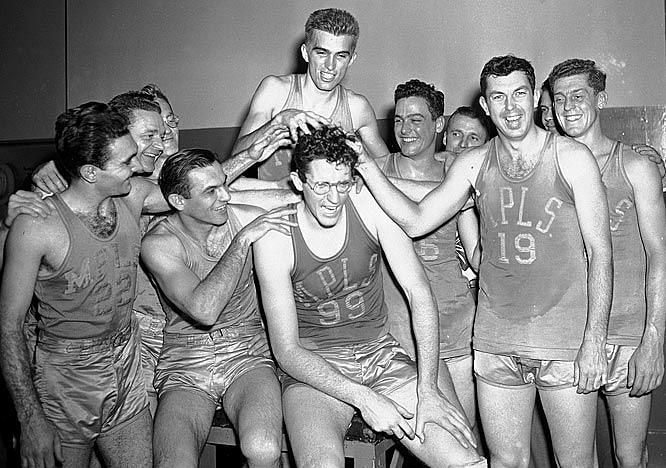
The 1950's in the NBA: Humble Beginnings, but a bright future

Modern-day basketball is one of the most captivating sports for the current generation of viewers and its popularity around the world is at an all-time high. The game has evolved into a hybrid version of its original self since the first official NBA season in 1949-50 and the way the game was played is sometimes difficult to remember unless you are a basketball aficionado. Here is a recap of what took place in the humble, but a captivating first decade of one of the biggest spectacles in the world.
1950 saw the first NBA championship being held under this banner. Although there are records of three other champions between the years of 1947-1949, it was still played under the Basketball Association of America (BAA) banner. This was the decade that laid the platform for what is the public spectacle known as the NBA Finals. Here we take a look at how the decade panned out, and what was the impact left behind after the decade had ended.
The first half of the 50s was dominated by the Minneapolis Lakers, who won the title in four out of the first years in the decade. They won it first in 1950 before losing in the Western Division final to the eventual champions, The Rochester Royals in 1951 in what was considered, at the time, the biggest upset in basketball history. After their shock 1951 defeat, the Lakers were able to bounce back by winning three consecutive titles between 1952-1954. The second half of the decade proved to be much more competitive with the Boston Celtics winning it twice in 1957 and 1959. The Syracuse Nationals (1955), The Philadelphia Warriors (1956) and The St. Louis Hawks (1958) were the other champions in the 1950s.
The team that was the unluckiest in this decade were the New York Knicks. They reached the finals for three consecutive years between 1951-1953 but agonizingly lost all three, with two of them going to a game seven. In 1951 they even came back from a 3-0 deficit against the Rochester Royals and were tied going into the last two minutes of the game at 75 points each. They eventually lost that game 79-75.
The NBA finals in the 50s were arguably the most tightly contested, spanning a decade with five of the champions decided in game seven:
1951 - Rochester Royals (4) - (3) New York Knicks
1952 - Minneapolis Lakers (4) - (3) New York Knicks
1954 - Minneapolis Lakers (4) - (3) Syracuse Nationals
1955 - Fort Wayne Pistons (3) - (4) Syracuse Nationals
1957 - St. Louis Hawks (3) - (4) Boston Celtics
George Mikan was the most successful player of the decade, winning four NBA titles with the Minneapolis Lakers. He retired first in 1954 but came back for a season in 1956. He then took over the reigns as head coach of the Lakers in 1957.
In this decade we also saw the debut of some of the greatest players to ever grace the court such as Bill Russell and Elgin Baylor.
Here are some of the multiple All-Star game participants of the 50s.
Bob Cousy (Boston Celtics) - 9x (1951-59)
Dolph Schayes (Syracuse Nationals) - 9x (1951-59)
Paul Arizin (Philadelphia Warriors) - 7x (1951-52, 1955-59)
Larry Foust (Fort Wayne Pistons/Minneapolis Lakers) - 7x (1951-56, 1958-59)
Bill Sharman (Boston Celtics) - 7x (1953-59)
Ed Mcauley (Boston Celtics/St.Louis Hawks) - 7x (1951-57)
Slater Martin (Minneapolis Lakers/New York Knicks/St.Louis Hawks) - 7x (1953-59)
Bob Petit (St.Louis Hawks) - 5x (1955-59)
George Mikan (Minneapolis Lakers) - 4x (1951-54)
Arnie Risen (Rochester Royals) - 4x (1952-55)
The NBA league MVP was introduced in this decade. The inaugural award was presented to Bob Petit in 1956. Petit won the award once again in 1959. Bob Cousy and Bill Russell who won the award in 1957 and 1958, were the two other players to receive the award in the 1950s.
The 50s, on the whole, was an absolutely groundbreaking decade for the NBA for the quality of play that the teams had managed to produce. This was the decade in which the shot clock was introduced, in the 1954-55 season that the Syracuse Nationals won. The introduction of the shot clock, coupled with the fact that there wasn't a three-point line meant players tried to get as close to the basket as possible before attempting a shot. The result of such a style of play was the domination of the Center and Power Forward position.
The taller players on the court essentially did most of the scoring, in addition to almost all the rebounding. In fact, there was a severe lack of shorter guards picked for All-Star games, of course with exceptions such as Bob Cousy, who made nine all-star appearances in the decade.
All of these factors resulted in producing some of the greatest Centers and Power Forwards ever to grace the floor, along with the occasional diamond in the rough among the guards and laid the foundation for the big man trend in the coming years and decades. This trend was lethal for the coming years and made any big man with a substantial skill set priceless and almost an essential for a team to compete for a title through the 60s and 70s.